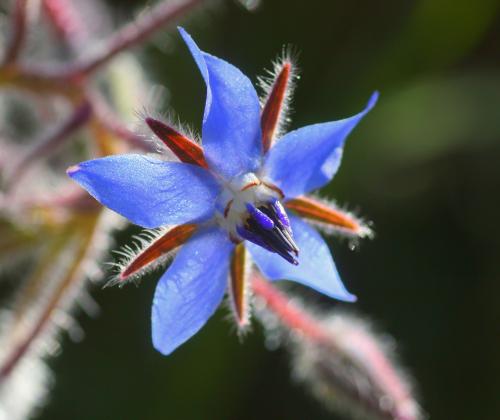Borago officinalis - Stress reliever sparks and sounds like fireworks when burned
Borago officinalis, borage, bee bush or starflower, is a Mediterranean native found in southeast Texas gardens as a warm weather annual. Seeds are planted in late winter or early spring to attract beneficial bees and wasps for summer crops. Beekeepers grow borage to boost honey production. Borage repels harmful insects such as the tomato hornworm, Manduca quinquemaculata. It removes salts from soil that is toxic to other plants. Borage is an excellent companion plant.
It is about 2 feet tall with a course gray-green hollow stem filled with clear mucilage. Stem and alternate leaves, 2 to 4 inches long, are covered with hairs. The genius name Borago, is from the Latin burra meaning a shaggy or hairy garment. Starshaped bright blue flowers hang down in clusters. There are pink and white varieties.
Borage is slightly salty with a mild cucumber flavor. Leaves and stem are pickled, used as a tea and cooked. You can eat it raw but unless finely chopped, texture will be an issue. Unlike other herbs, borage leaves are not used in their dry form. Flowers decorate cakes and drinks, are candied, used in salads, etc. Borage has vitamins A and C and minerals including iron, calcium, potassium, magnesium, etc. Its mineral salts cause it to spark and make small fireworks sounds when burned. The ashes can be used as a salt substitute. For millennia traditional medicine has used borage to relieve anxiety and stress. Greek physician Dioscorides (40 - 90 CE) wrote De materia medica, five volumes of information about medicinal plants and medicines used by physicians for more than 1500 years. He said borage was to “cheer the heart and to lift the depressed spirits”. Roman soldiers took borage before battles. “Borage for courage!” Ladies embroidered borage on scarves worn by knights fighting in tournaments. Other medicinal uses treated the skin, fever, arthritis, respiratory issues, high blood pressure, women’s issues, etc. Borage is grown commercially for borage seed oil, an anti-inflammatory extracted from its seeds. Borage products are in pharmacies and health food stores. There are often warnings for those with liver problems.
Below are a few of many borage articles from the National Institutes of Health, nlm.nih.gov.
• “Effect of Borago Officinalis Extract on Moderate Persistent Asthma: A Phase two Randomized, Double Blind, Placebo-Controlled Clinical Trial”.
• “Protective Effect of Borage Seed Oil and Gamma Linolenic Acid on DNA: In Vivo and In Vitro Studies”. “Borage (Borago officinalis L.) seed oil has been used as a treatment for various degenerative diseases.”
• “Cancer Prevention and Health Benefices of Traditionally Consumed Borago officinalis Plants”. “In conclusion, the results showed that B. officinalis may represent a high value plant for pleiotropic uses and support its consumption as a nutraceutical plant.” Pleiotropic means producing more than one effect.
• “Self-help interventions for depressive disorders and depressive symptoms: a systematic review”. “There is preliminary evidence that borage flower extract may be helpful for depression. Longer trials with larger samples are needed to confirm these results.”
Deborah Richardson is a freelance reporter for The Examiner with a fondness for flora in its natural setting.


